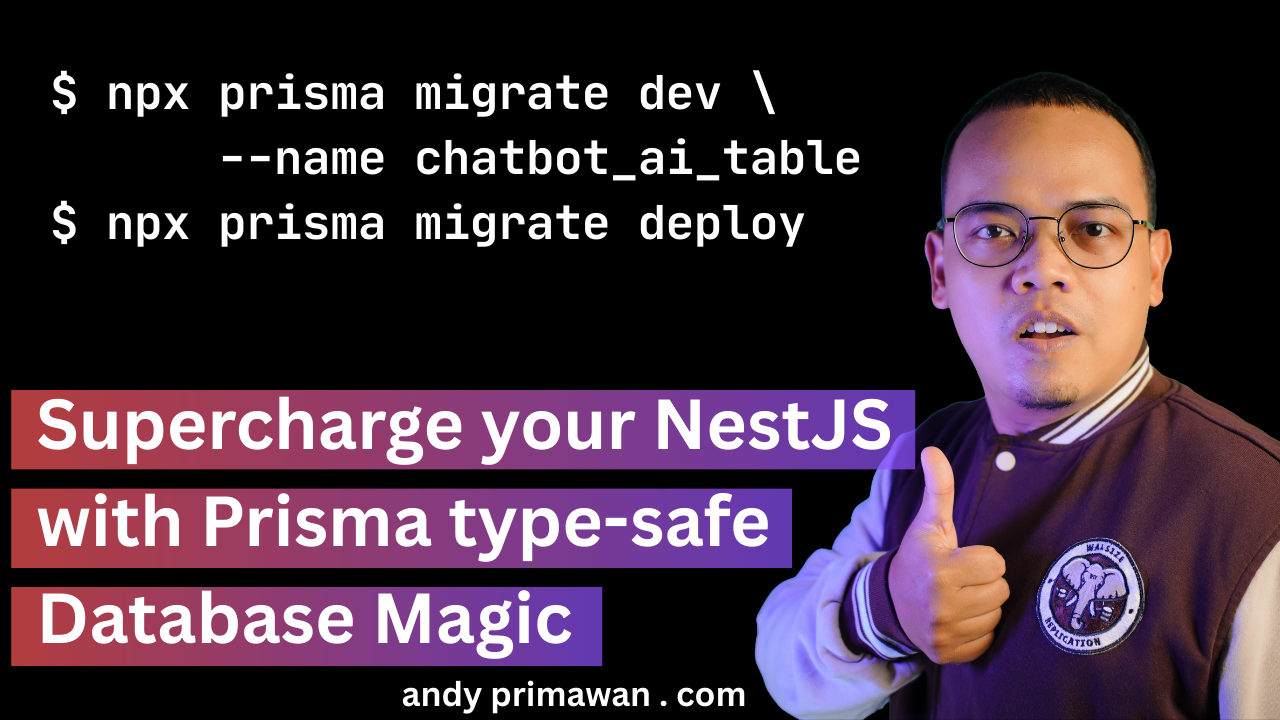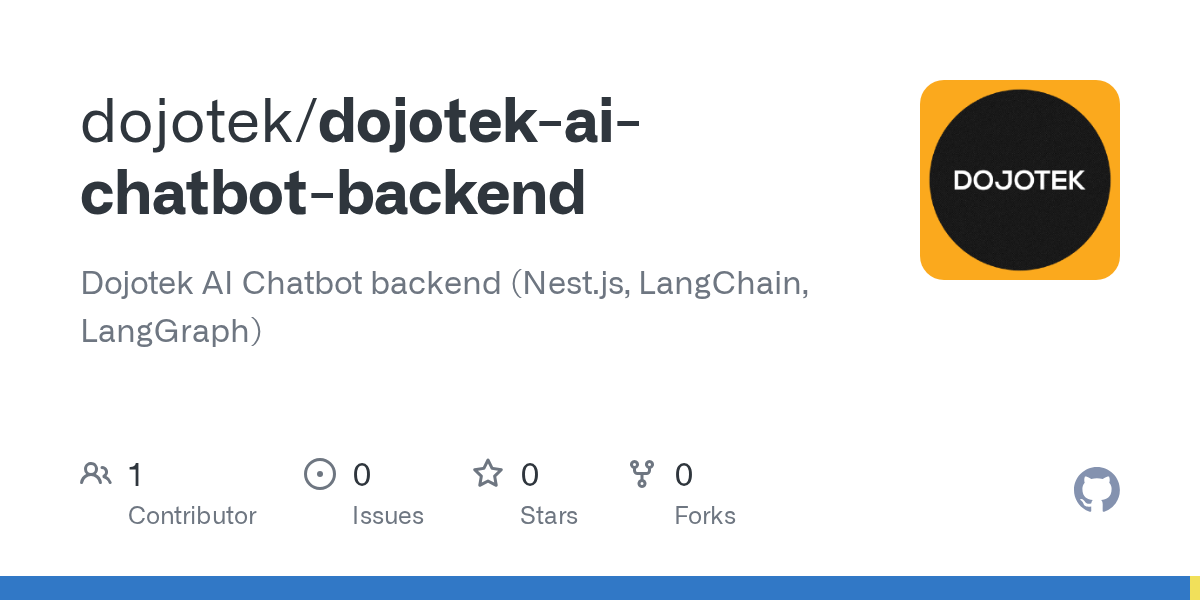Supercharge Your NestJS API with Prisma's Type-Safe Database Magic - Andy Primawan
Tired of runtime DB errors in your NestJS app? Prisma brings full end-to-end type safety, from your API down to your PostgreSQL or MySQL database. Let's explore how to build truly robust and maintainable backends.

As full-stack engineers, we juggle a lot of moving parts. On the backend, we often reach for the trusty relational databases that have powered applications for decades—PostgreSQL and MySQL are still the undisputed champions for a reason. They're reliable, structured, and powerful.
On the application side, many of us have found a sense of calm and order by building with NestJS. Its modular architecture combined with TypeScript's strong typing gives us the confidence to build and scale enterprise-grade applications without losing our minds.
But there's always been a slight disconnect, a gap where that beautiful type safety from TypeScript doesn't quite reach: the database layer. We write our services, and then... we interact with a database client like pg or mysql2. We might be writing raw SQL strings or using a query builder, but the compiler is essentially flying blind. It can't validate our queries or guarantee that the data we receive matches the shape we expect.
What if we could bridge that gap? What if we could have full, end-to-end type safety, from the incoming HTTP request all the way to the database row?
That's exactly what Prisma brings to the table.
What's the Big Deal with Prisma?
Prisma is a next-generation ORM (Object-Relational Mapper) for Node.js and TypeScript. It takes a unique, schema-first approach to database interaction. Instead of defining models in your code and trying to sync them with the database, you do the opposite.
Here's the high-level workflow:
- Define Your Schema: You create a single
schema.prismafile. This becomes the single source of truth for your database schema and your application's data models. prisma.io emphasizes this schema-centric approach. - Migrate Your Database: You run a command (
prisma migrate dev), and Prisma inspects your schema, generates the necessary SQL migration files, and applies them to your database. This process is transparent and customizable medium.com. - Generate Your Client: Prisma then generates a fully type-safe database client (
PrismaClient) that is tailor-made for your specific schema.
The result? When you write prisma.user.findMany(...), your IDE knows exactly what fields a user has, what relations it includes, and what arguments you can use to filter and sort. No more guesswork, no more any types.
A Typical Project Structure
Before we dive in, let's visualize how this fits into a standard NestJS project. The structure is clean and intuitive.
/andy-primawan-chatbot-ai-app
├── prisma/
│ ├── schema.prisma
│ └── migrations/
├── src/
│ ├── prisma/ # A dedicated module for our Prisma service
│ │ ├── prisma.module.ts
│ │ └── prisma.service.ts
│ ├── users/
│ │ ├── dto/
│ │ ├── users.controller.ts
│ │ ├── users.service.ts
│ │ └── users.module.ts
│ ├── roles/
│ │ └── ... (similar structure)
│ ├── app.module.ts
│ └── main.ts
└── ... (package.json, tsconfig.json, etc.)
Let's Get Our Hands Dirty: The Setup
First things first, let's get the necessary packages installed in our NestJS project.
# Install Prisma Client
$ npm install @prisma/client
# Install the Prisma CLI as a dev dependency
$ npm install prisma --save-dev
Next, initialize Prisma. This command creates the prisma directory and a basic schema.prisma file for you.
$ npx prisma init
This will set up your schema.prisma with a datasource block. Go ahead and configure it for your database (we'll use PostgreSQL here, but MySQL is just as easy).
// prisma/schema.prisma
generator client {
provider = "prisma-client-js"
output = "../src/generated/prisma"
}
datasource db {
provider = "postgresql"
url = env("DATABASE_URL") // Uses the .env file!
}
Demo 1: Modeling Roles and Users
Now for the fun part. Let's model a simple User and Role relationship in our schema.prisma file. This declarative syntax is incredibly readable.
// prisma/schema.prisma
// ... (generator and datasource blocks from above)
model Role {
id String @id @default(uuid(7)) @db.Uuid
name String @unique @db.VarChar(100)
description String? @db.Text
permissions Json? @db.JsonB
createdAt DateTime @default(now()) @map("created_at") @db.Timestamp(6)
updatedAt DateTime @updatedAt @map("updated_at") @db.Timestamp(6)
users User[]
@@map("roles")
}
model User {
id String @id @default(uuid(7)) @db.Uuid
email String @unique @db.VarChar(255)
password String @db.VarChar(255)
name String? @db.VarChar(255)
roleId String @map("role_id") @db.Uuid
isActive Boolean @default(true) @map("is_active")
createdAt DateTime @default(now()) @map("created_at") @db.Timestamp(6)
updatedAt DateTime @updatedAt @map("updated_at") @db.Timestamp(6)
role Role @relation(fields: [roleId], references: [id])
@@map("users")
}
Demo 2: Generating and Applying Migrations
With our models defined, we can now tell Prisma to create and run a migration to build these tables in our database.
# This command does three things:
# 1. Creates a new SQL migration file based on schema changes.
# 2. Applies the migration to the database.
# 3. Re-generates the Prisma Client.
$ npx prisma migrate dev --name create_roles_and_users_table
You'll see a new folder under prisma/migrations containing a .sql file with the CREATE TABLE statements. You have full visibility into what's happening.
For production environments or CI/CD pipelines, you'd use a non-interactive command to apply pending migrations:
$ npx prisma migrate deploy
Demo 3: The NestJS Prisma Service
To use Prisma efficiently across our NestJS application, we'll follow a best practice: creating a singleton PrismaService that can be injected into other services.
First, create the service that extends the PrismaClient and handles database connections.
// src/prisma/prisma.service.ts
import { Injectable, OnModuleInit, Global } from '@nestjs/common';
import { PrismaClient } from '../generated/prisma/client';
@Global()
@Injectable()
export class PrismaService extends PrismaClient implements OnModuleInit {
async onModuleInit() {
await this.$connect();
}
}
Next, create a module to provide and export this service.
// src/prisma/prisma.module.ts
import { Module } from '@nestjs/common';
import { PrismaService } from './prisma.service';
@Module({
providers: [PrismaService],
exports: [PrismaService], // Export for other modules to use
})
export class PrismaModule {}
Finally, import PrismaModule into the root AppModule or any feature module (UsersModule, etc.) where you need database access.
Demo 4: Type-Safe CRUD Operations
This is where all the setup pays off. Let's create a UsersService that uses our injected PrismaService to perform CRUD operations. Notice the amazing autocompletion and type-checking you'll get in your editor.
// src/users/users.service.ts
import { Injectable, NotFoundException } from '@nestjs/common';
import { PrismaService } from '../prisma/prisma.service';
import { CreateUserDto } from './dto/create-user.dto';
// Below is our generated type!
import { User } from '../../generated/prisma/client';
@Injectable()
export class UsersService {
constructor(private prisma: PrismaService) {}
// CREATE
async create(createUserDto: CreateUserDto): Promise<User> {
// The `data` object is fully typed!
return this.prisma.user.create({
data: createUserDto,
});
}
// READ all with filtering and pagination
async findAll(page: number = 1, limit: number = 10, emailDomain?: string): Promise<User[]> {
const skip = (page - 1) * limit;
return this.prisma.user.findMany({
skip,
take: limit,
where: {
email: {
contains: emailDomain, // Type-safe filtering!
},
},
include: {
roles: true, // Also fetch related roles
},
});
}
// READ one by ID
async findOne(id: string): Promise<User | null> {
const user = await this.prisma.user.findUnique({
where: { id },
});
if (!user) {
throw new NotFoundException(`User with ID "${id}" not found.`);
}
return user;
}
// UPDATE
async update(id: string, updateUserDto: UpdateUserDto): Promise<User> {
return this.prisma.user.update({
where: { id },
data: updateUserDto, // `updateUserDto` is also checked
});
}
// DELETE
async remove(id: string): Promise<User> {
return this.prisma.user.delete({
where: { id },
});
}
}
Look at that findAll method. We can implement filtering, pagination, and relations with a simple, readable, and fully type-safe object. Pretty sweet, right? You can explore the database visually with Prisma Studio (npx prisma studio), a command that opens a local admin UI for your database.
Conclusion
Pairing NestJS with Prisma isn't just about adding another library to your stack. It's about fundamentally improving the reliability and developer experience of your backend development.
You get:
- End-to-End Type Safety: No more silent
undefined is not a functionerrors because a column name changed. - A Single Source of Truth: The
schema.prismafile defines your data shape for both the database and the application. - Incredible Autocompletion: Less time looking up docs, more time coding.
- Readable & Maintainable Queries: A declarative API that's a joy to work with.
For building scalable, robust, and maintainable applications, the combination of NestJS's architecture and Prisma's data-layer safety is a match made in developer heaven.
Show Me the Code!
Want to see all these pieces working together in a complete project? Check out the full source code on my Dojotek AI Chatbot GitHub repository.

